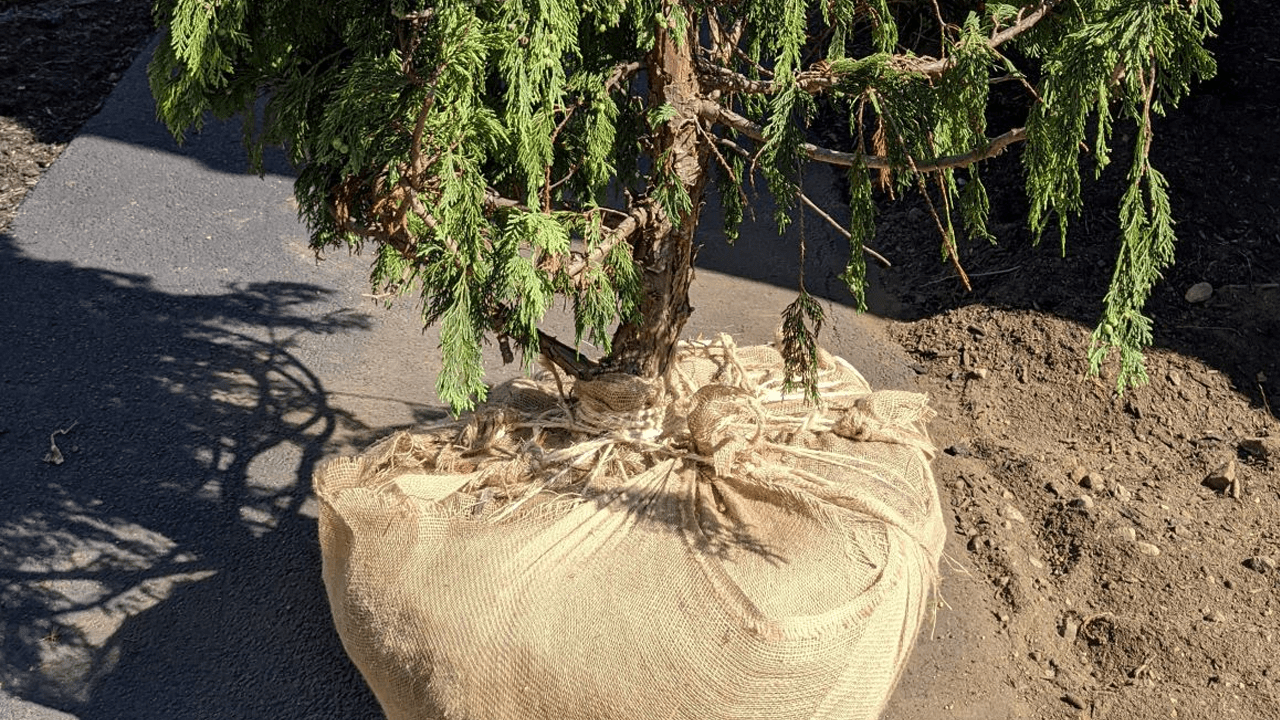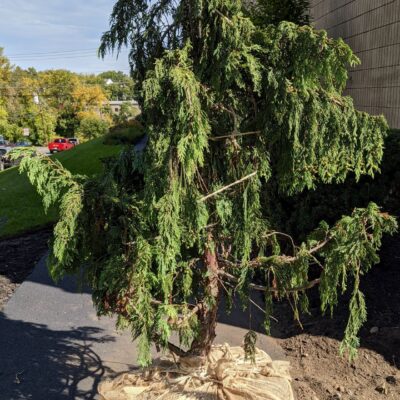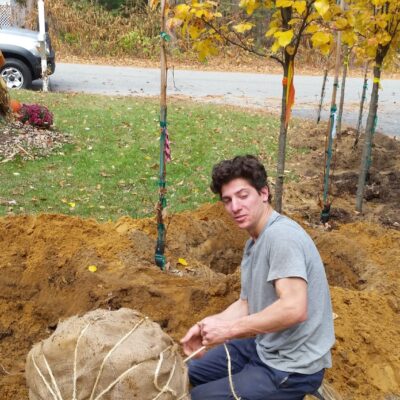Late winter-early spring is the time to transplant trees. Here, we will discuss both bare root and ball & burlap techniques. In each case, trees ought to be dug during dormancy, that is, before they break bud.
Tools needed to dig bare root trees:
- Garden spade
- Garden fork
- Steel rake
- Mulch fork
- Bypass pruner
- Pry bar or 5’ rebar
- Small sledge
Materials needed to dig bare root trees:
- 2 or 3 ply twine
- Burlap, heavy weave
- 6-gallon bucket
- Source of water
- Wooden or bamboo garden stake
The pros of digging trees bare root:
- Easier to dig
- Lighter weight (easier to move)
- Weed-free transplant
- Can inspect roots for damage or disease
- Most people can do this!
The cons of digging trees bare root:
- Only for smaller caliper trees (generally <2.0”)
- Short period of time when trees can be moved
| SIDEBAR: The difference between a garden spade and a shovel: a garden spade has a rectangular blade and is used primarily for cutting and edging; whereas a shovel has a pointed blade that is used primarily for digging and moving soil. |
Digging trees is both an art and science. The science is outlined in American Nation Standards Institute (ANSI) A300 part 6: planting and transplanting. The guidelines specify the size of the root diameter to be excavated based upon the trees caliper. In general, for each inch in caliper a 10 to 12” of root diameter needs to be dug.
Trees grown in nurseries are regularly root pruned in order to encourage fibrous roots to grow close to the tree stem. This is the reason why nursery grown tree transplants have greater success than trees from a woodland (which have sparse, far-ranging roots). Therefore, it is best to purchase nursery grown trees for planting into the landscape, and leave the woodland trees where they are to enjoy in place.
Trees may also be started or grown on by the gardener. These include:
- Starting trees from collected seed
- Trees started from cuttings
- Planting out purchased liners
There are a number of trees that you may propagate from seed that are collect locally. There are definite advantages from growing trees from local sources. Locally collected seeds are best adapted (genetically) to your environment. This is referred to as plant provenance.
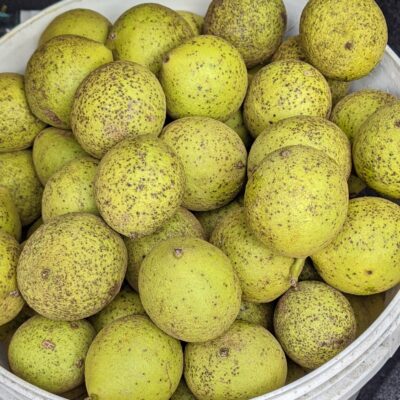
However, there are a number of reasons to purchase trees online. These small diameter trees are termed whips or liners. When purchasing trees, purchase from sources that grow trees in one USDA plant hardiness zone colder than where you live. Buy trees online when you:
- Are interested in a specific varietal not locally available
- Want an heirloom varietal
- Want a grafted (dwarf or semi-dwarf) tree
- Want a disease resistant tree
Examples of trees to grow include orchard trees (apples, persimmons, chestnuts), flowering and ornamental trees. Many fruit trees are grafted onto rootstock and inter-stock to develop semi-dwarf or dwarf trees. A particular interest these days is rediscovering and preserving heirloom trees (apples, in particular).
Select chestnuts for disease resistance. Purchase cultivars that have Asian stock (Castanea mollisima or C. crenata) that impart resistance against Chestnut blight (Cryphonectria parasitica) which has devastated the native chestnut (C. dentata). Examples are crosses of C. mollissima (Chinese chestnut) and native chestnut such as ‘Revival’, and crosses of Japanese chestnut (C. crenata) and the European chestnut (C. sativa).
Whips are often fairly small in caliper, usually ¼ to ½”. The smallest available are the least expensive, but may require a year or two in an area set aside in a nursery to grow on until transplant. Larger trees (½ – 1” caliper) may be planted directly into their final location.
| SIDEBAR: In the Blue Ridge Mountains, NC peaches tend to break bud early. Growers in this area have focused on apples (which break dormancy relatively late), though some are interested in trialing peach for the purpose of diversification. Although the last spring frost date is April 20th, frosts may occur as late as mid-May. We are trialing late bud break cultivars here that include:
· Carolina Gold · Contender · Jefferson · Veteran Cultivars that break bud later in the spring have a better chance of setting a fruit crop. |
Transplanting Small Caliper Trees by the Bare Root Method
Steps to transplanting trees bare root:
- Tie the branches together
- Measure tree caliper
- Mark out how far out to dig from the stem
- Excavate deep enough to undercut the anchoring roots
- Root prune damaged or overlong roots
- Keep trees covered and moist
- Heel in trees or plant out
- Prune any broken, diseased or crossing branches
- Stake tree
- Water in well
- Mulch
First tie the branches together using 2-ply twine. This will get you and the branches out of harm’s way!

Measure tree caliper, which is the stems’ diameter 6” above the soil line. If using a ruler, hold to the stem to get a caliper measurement. If using a cloth tape wrapped around the stem, divide the measurement by 3.14 to get the diameter. Of course, if you have a DBH tape, your circumference measurement is already converted to diameter for you.
Once you have determined the tree diameter, multiply the caliper by 12 to determine how big to dig the tree. For example, if the tree has a 1” caliper, excavate a 12” “rootball”. Use a gardening fork to dig around the tree, removing the soil from the roots. Dig a minimum of 12” deep, and rock the tree. If the tree is still firmly rooted, excavate deeper with a garden spade, cutting in at an angle to sever any remaining roots.
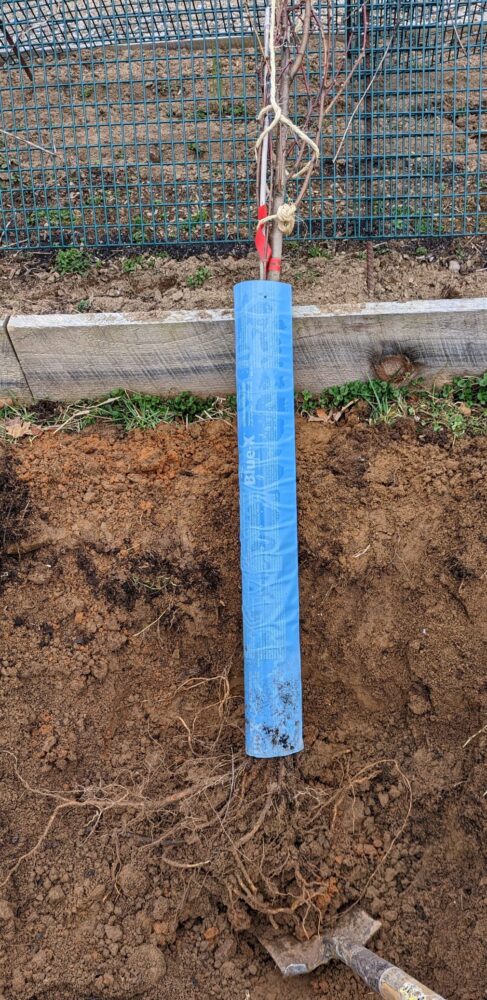
Once excavated, cut any damaged or overly long roots cleanly using a bypass pruner. Once dug, keep the roots covered with moist burlap or place the tree in a bucket with water. Exposure to ultraviolet rays will kill roots as will drying from sun and wind.
Plant the tree placing in the planting hole to the same depth it was growing in the nursery. Dig the hole wide and deep enough to accommodate the roots without crowding. This is a good time to prune any broken, diseased, or crossing branches. Use a pry bar or 5’ rebar and sledge to make a pilot hole for a tree stake. A single stake should be sufficient. Use a strip of burlap to loosely tie the tree to the stake. Backfill with the soil you removed, and water in to settle the soil around the roots. Air pockets in the soil will dry roots, so water in immediately after planting.
Do not fertilize at the time of planting, but you can water in with a liquid kelp solution. Kelp (e.g., Ascophyllum nodosum) provides auxins, cytokinins and gibberellins which are phyto-chemicals that enhance plant growth. Cytokinins in particular incite cell division, which is helpful in restoration of roots lost during the transplant process.
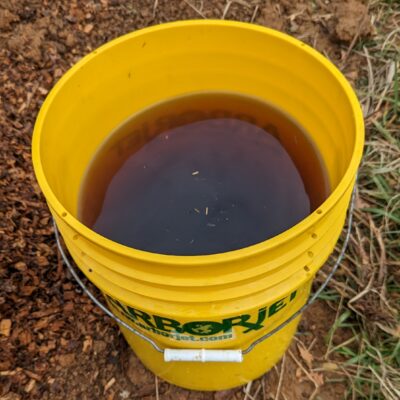
Finally, apply 4” of mulch around the tree. Use woodchips, straw or leaf mold to mulch. Avoid bark chips (which are primarily lignin), as they do not add much organic matter to the soil.
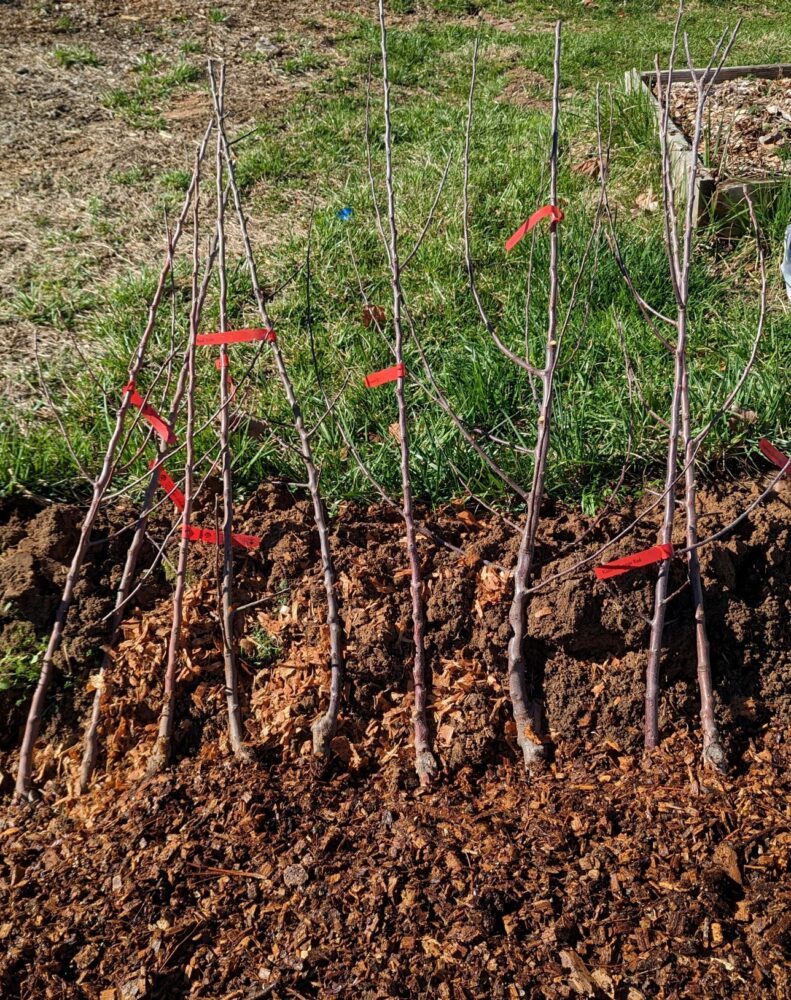
Pro Corner: Digging Trees by Ball & Burlap
Tools needed to dig a tree B&B:
- Garden spade
- Bypass pruner
- Lopper
- Shovel
- Tree ball cart
Materials needed to dig a tree B&B:
- 2 and 3 ply twine
- Burlap, heavy weave
Digging ball & burlap is reserved for larger diameter trees. Generally, the nursery will B&B trees. The advantages of ball & burlap include:
- Extends the planting season
- Trees do not need to be immediately planted
- Larger diameter trees (usually 2-3” DBH) may be safely moved
The disadvantages of B&B trees:
- Expertise is required to dig a B&B tree
- Trees are heavier to move
- Specialized equipment is often needed to move larger trees
Many of the trees transplanted today are machine dug. Here, we will discuss how trees are dug using a manual technique. As with bare root, tie the canopy branches using 2 or 3 ply twine. Next determine the diameter of the ball to be dug. Even in larger diameter (2-3”) trees, the fibrous (absorbing) roots range to 12” depth. However, larger anchoring roots may range more deeply (16-18”). A spade is used to cut into the soil, at the perimeter extent of the dig. Large roots (>1/2” diameter) should be cut with a long-handled lopper. Excavate down to a depth of 18”, then using the spade, cut to taper the root ball at a 45° angle taking care not to fracture the root ball. Cut large roots with a lopper.

Drape burlap squares around the tapered ball, overlapping at least 6” as you go. Using a doubled length of 3-ply twine, tie a “bottom band,” that is, loop around the base of the rootball. Do the same around the top perimeter. Next, loop 3-ply from the top band through the bottom band to form a drum lacing pattern, working the sisal between the burlap and bottom and top bands. Once around the entire ball, tighten the drum lacing by pulling up on each length, working around and tie off. Next, tie a length from the top band perimeter and work around the tree stem. Wrap burlap around the tree stem to form a top collar to protect the bark. Tighten as you go, and with each length, turn 90° around the stem. When you have pulled in the top band, the lacing from the top ought to be star shaped. Tie off. Using a new piece of burlap, rolled in half, place under the tree to create a bottom bag. The opposite ends of the bottom bag are tied together. Alternatively, pull the existing burlap and fold under the tree, using 3-ply, cross the bottom lacing (as on top) and tie off. Each technique requires tipping the tree to one side. This later technique eliminates the bottom bag, but may be harder to tie off in the hole. Your tree is now ready to be moved!
In the next installment: early spring flowering trees and shrubs!
~ Signing off for now, Joe

